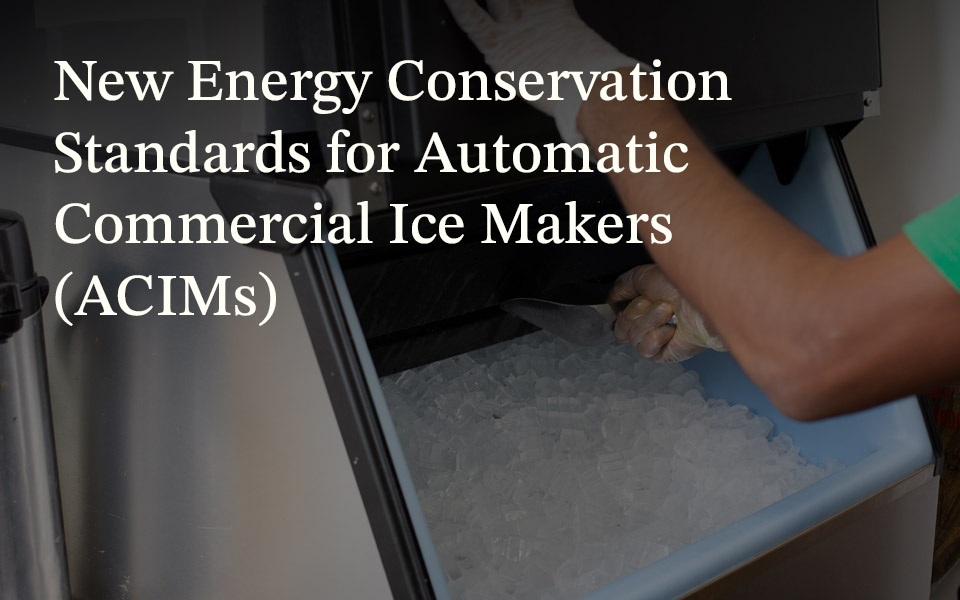Earlier this year, the Department of Energy (DOE) published a notice of proposed rulemaking (NOPR) outlining new energy conservation standards for automatic commercial ice makers (ACIMs). The proposal calls for energy reductions up to 30 percent, which would apply to most of the ACIM equipment currently on the market. In a recent article for QSR Magazine, I explored the implications of this new DOE proposal within the context of an already dynamic regulatory climate.

Today, the DOE estimates that only 37 percent of current ACIM equipment can meet its proposed efficiency standard; the other 63 percent will likely need design improvements to achieve certification. The proposed rule would apply to all types of ACIMs manufactured in or imported into the United States and take effect three years after the date on which the final rule is published. This likely would set the compliance year to as soon as 2027 and give original equipment manufacturers (OEMs) little time to complete their design cycles.
Batch and continuous ACIM types are included within the scope of the proposal, as well as a new class of small-batch ACIM equipment that had not been covered under previous DOE standards.
Evolving regulations and efficiency standards
The proposed DOE ruling is not the only regulatory consideration for the ACIM supply chain. The Environmental Protection Agency (EPA) published its Technology Transitions rule in October, which established global warming potential (GWP) limits and refrigerant restrictions in support of the hydrofluorocarbon (HFC) refrigerant phasedown.
Per the EPA’s final Technology Transitions rule, refrigerants used in self-contained and remote ACIMs are determined by the ice production method (i.e., batch or continuous) and daily harvest volumes.
- Self-contained, factory-charged ACIMs of smaller volumes (≤ 1,000 lbs of batch type; ≤ 1,200 lbs of continuous type) have a GWP limit of 150 — with a manufacture compliance date of Jan. 1, 2026.
- Self-contained, factory-charged ACIMs of higher volumes (> 1,000 lbs of batch type; > 1,200 lbs of continuous type) cannot use any of the 38 restricted HFCs specified in the rule — with a manufacture compliance date of Jan. 1, 2027.
- Remote, field-charged ACIMs cannot use any of the 21 restricted HFCs specified in the rule — with an install compliance date of Jan. 1, 2027.
The DOE has recognized that these GWP limits and refrigerant restrictions could impact the ACIM sector and has asked for public comments on how to align its proposal with the new EPA ruling.
Version 3.0 (2018) of the EPA’s optional ENERGY STAR® program established another efficiency standard for ACIMs, addressing not only energy consumption but also the efficient use of water. The EPA periodically updates its ENERGY STAR minimum efficiency certifications to align with DOE standards; thus, a revision is expected in the coming years.
Natural Resources Canada (NRCan) has also listed minimum performance requirements for ACIM cubers and flakers under Canada’s energy efficiency (CEE) regulations. To date, these standards have been harmonized with U.S. regulations.
ACIM design considerations
Per the DOE’s assessment of ACIM designs, up to 20 technological design options have been identified to help OEMs reduce unit energy consumption — not including upgrading to a more energy-efficient compressor. However, OEMs are exploring higher-efficiency compressors and motors and improving heat exchanger performance to help them meet DOE, ENERGY STAR and CEE performance specifications.
Considering the convergence of DOE and EPA regulations, many OEMs are taking the opportunity to combine design cycles to address energy efficiency and lower-GWP refrigerant mandates in compressor selection. Copeland is working closely with our OEM partners and key industry organizations to better align these separate, yet related, regulatory efforts.
To stay informed of the ever-evolving regulatory landscape and learn more about the DOE’s ACIM proposal, please visit our resource center.

Six Ways to Reduce Food Waste by Tracking the Supply Chain
*Emerson’s Climate Technologies business is now a new standalone company: Copeland. Over the next...

Protect Valuable Shipments in High-Crime Areas
*Emerson’s Climate Technologies business is now a new standalone company: Copeland. Over the next...

Real-time Tracking Protects Valuable Mango Cargo
*Emerson’s Climate Technologies business is now a new standalone company: Copeland. Over the next...